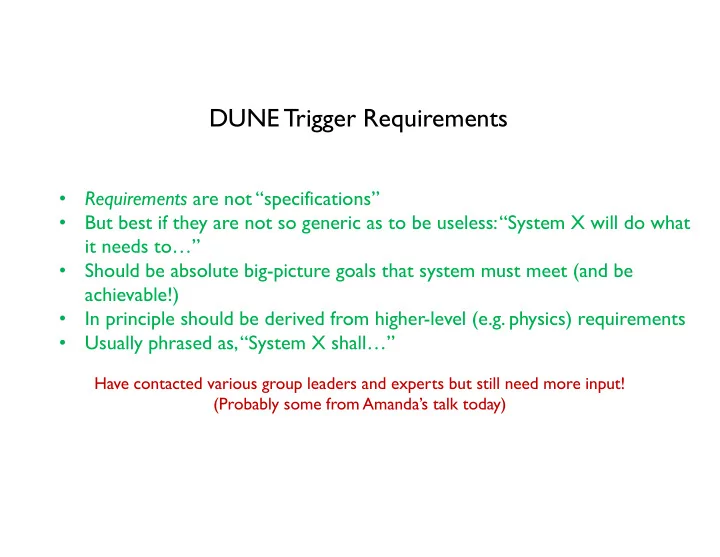

DUNE Trigger Requirements • Requirements are not “specifications” • But best if they are not so generic as to be useless: “System X will do what it needs to…” • Should be absolute big-picture goals that system must meet (and be achievable!) In principle should be derived from higher-level (e.g. physics) requirements • Usually phrased as, “System X shall…” • Have contacted various group leaders and experts but still need more input! (Probably some from Amanda’s talk today)
DUNE Trigger Requirements Starting Points:
Data selection shall: • operate on both SP and DP data streams Rationale: Collaboration requirement • act independently and in concert from all four detector modules Rationale: Maintain sensitivity during downtimes as well as full 40 kt for Supernova bursts • enable filtering of data stream so that data on disk can be limited to < 10 PB/year Rationale: Reasonable limit for downstream analysis and storage Comments: “Enable” means downstream nearline can filter further • be deadtimeless Rationale: No excuse to be otherwise; maximum livetime for follower events, supernova bursts • act on information from TPC, PDS, timing system, and any auxiliary calibration systems Rationale: Provide robustness to variations in noise; needed for detector calibrations include timestamps for all events of interest • Rationale: Allow tests in offline analysis; coordinate with other expts; provide unique IDs • provide tags for various types of selected data, written as part of data stream Rationale: Provide simple sorting for online and offline analyses; allow systematic checks • act as a “master” for calibration systems as necessary Rationale: Simplify tagging and run control interface • provide self-triggering modes (e.g., random triggers, pulsers) Rationale: Systematic checks of overall detector health
Data selection shall: • provide pre-scaling for all trigger types as well as rejected data Rationale: May need to deal with high-rate calibration sources, or low-threshold triggers • Provide a coarse estimate of event centroid Rationale: Allow zero suppression via location • provide statistics for data selection to online monitoring Rationale: Detector health feedback • allow partitioning for commissioning and debugging, within modules Rationale: Commissioning of elements that may come together at different times
Data selection shall: • be >99% efficient for selection of neutrino events within beam spills with E vis > 100 MeV Rationale: Best exploitation of beam data • be >99% efficient for selection of atmospheric n s and nucleon decay events with E vis > 100 MeV Rationale: Smaller total flux in low (<100 MeV) window Comments: Change this to 50 MeV? 20 MeV…? • be >90% efficient for selection of supernova bursts within the Milky Way Rationale: Seems reasonable? • be >90% efficient for single supernova events within a burst for E vis >5 MeV Rationale: Seems reasonable? • Supernova Burst false trigger rate contributes < 10% of total data bandwidth “Loose” zero suppression still needs about x10 reduction 100 µ s x 2 MHz x 12 bits/8bits x 40 MBq =12 GB/s for full detector) = 120 PB/year
Data Selection Critical Questions Is a simple trigger criterion enough to remove 39 Ar “SN Bursts”? • Warburton Rivera 8 10 Ntuple trigger rate (Hz) ∆ t 5ms 7 10 2ms 1ms 6 10 0.75ms D t = 50 µ s 0.5ms 5 10 0.25ms 4 10 3 10 2 10 10 1 Number of Adj Hits − 1 10 0 2 4 6 8 10 12 14 16 Adjacent wire multiplicity At an adjacent multiplicity of 6 hits and D t=750 µ s, we get about 1 Hz (1 event each!) in 10 ktonnes. So 10 “SN events” in 10 s. Tiny probability of 100 events Number of Adj Hits in 10s. (Expect ~250 events/10 ktonnes at 10 kpc)
Data Selection Critical Questions Is a simple trigger criterion enough to remove 39 Ar “SN Bursts”? • Warburton Rivera 8 10 Ntuple trigger rate (Hz) ∆ t µ 7 500 s 10 µ 50 s 6 10 µ 40 s D t = 50 µ s 5 10 µ 20 s 4 10 3 10 2 10 10 1 − 1 10 − 2 10 0 2 4 6 8 10 Adjacent wire multiplicity At an adjacent multiplicity of 4 hits and D t=50 µ s, we get about 0.1 Hz (1 event each!) in 10 ktonnes. So 1 “SN event” in 10 s. Tiny probability of 100 events in Number of Adj Hits 10s. (Expect ~250 events/10 ktonnes at 10 kpc)
Data Selection Critical Questions What are we storing for any given “SN Burst”? • If we store everything (no zero suppression for 10 s) then that is ~450 TB for each burst. We can tolerate just 2 such bursts each year if we stick with our 10% of total data requirement. Zero-suppressing just collection wires brings this down to ~250 GB, so we could tolerate ~4000 fake bursts, or ~10/day. If we only save zero-suppressed data for everything, data selection needs on 1/5 reduction. It basically becomes a tagging scheme.
Data Selection Critical Questions Is simple adjacent multiplicity enough for high energy (non-beam) events? • K + -antinu can have K+ going normal to wire planes---we lose these if we require high multiplicity, but acceptance loss probably small. Nevertheless, we can gain these back with time-over-threshold and/or total charge---what does multiplicity vs. time-over-threshold vs. charge look like for high-E events?
Data Selection Critical Questions What should we assume about coherent noise? • Coherent noise may be rejected with a D t>N µ s cut---how big is acceptance loss? And what does collection wire “charge” look like for this?
Recommend
More recommend